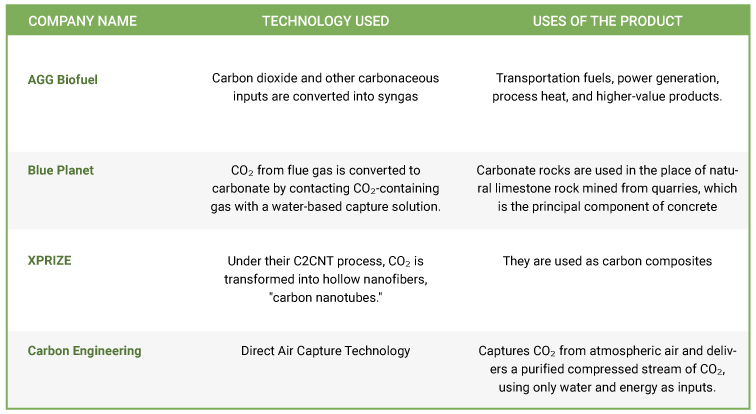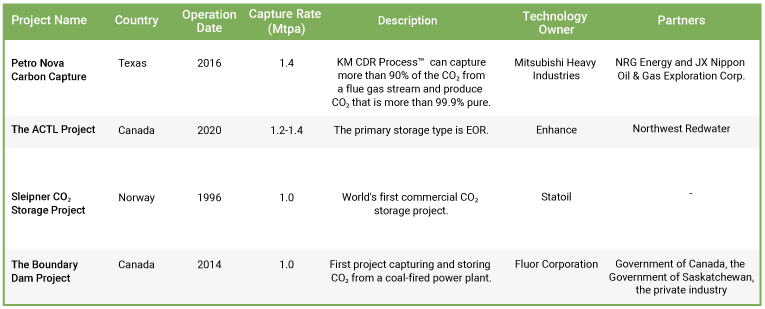Carbon dioxide concentrations are rising mainly by the burning of fossil fuels. The global average amount of carbon dioxide reached record levels of 412.5 parts per million, rising by 2.6 ppm that year. In 2019, it was 409.8 ppm, a rise of approx. 2.5 ± 0.1 ppm from 2018, the same as the increase between 2017 and 2018. Since carbon dioxide is the most vital gas in the earth’s system, natural rises in its concentrations have repeatedly warmed the earth’s atmosphere during the ice age cycle over the past million years. Various start-ups such as See O2 Energy, MIRRECO, and Hexas Biomass are working worldwide on energy technologies to break down GHGs into fuel, which later can be used to generate heat. Because if global energy demand rises and is met mostly with fossil fuels, atmospheric carbon dioxide is projected to surpass 900 ppm by the end of this century.
So, to stop carbon emissions, CarbonCapture, storage, and utilization, or CCSU, an emissions reduction technology has been adopted globally. CCSU revolves around various technologies to remove CO₂ from the flue gas and the atmosphere, then recycle the CO₂ for utilization and storage. Despite the adoption of systems to reduce the rate of CO₂ emissions, the cumulative amount of CO₂ in the atmosphere needs to be decreased to limit the detrimental impacts of climate change.
CO₂ Capture Options:
CO₂ capture aims to produce a concentrated stream of CO₂ at high pressure that can readily be transported to a storage site. There are three main processes for capturing the CO₂ generated.
- Post-conversion capture involves separating CO₂ from waste gas streams after converting the carbon source to CO₂. These systems commonly use a liquid solvent to capture the small fraction of CO₂ present in a flue gas stream in which the primary constituent is nitrogen (from the air).
- Pre-conversion capture refers to capturing CO₂ generated as an undesired co-product of an intermediate reaction of a conversion process. Even if the initial fuel conversion steps are costlier than in post-combustion processes, the obtained high concentrations of CO₂ and the high pressure in this approach are more favorable for CO₂ separation.
- In oxyfuel combustion capture, fuel is burned with pure oxygen to produce flue gas with high CO₂ concentrations and free from nitrogen and compounds. In oxyfuel combustion, CO₂ stored is not a fraction removed from the flue gas stream, but the flue gas stream itself.
CO₂ Transportation Options:
The accessibility of transportation to transport CO₂ safely is vital for the implementation of CCSU, done via pipeline and ship.
CO₂ Storage Options:
Once captured, then CO₂ is stored by various options. These include storage of gases in deep geological formations and solid storage by reaction of CO2 with metal oxides to produce carbonates. It was once suggested that CO2 could also be stored in oceans, adding to ocean acidification. That’s why it was banned under the London and OSPAR conventions. CO₂ storage in geological formations is at present perhaps one of the most reassuring choices.
- Geologic carbon sequestration stores carbon dioxide (CO₂) in deep geologic formations to avoid releasing it into the atmosphere. After capturing CO₂, it would be compressed to ≈100 bar to convert into a supercritical fluid because CO₂ would be easy to transport to storage. The CO₂ would then be injected around 1 km deep underground to be stable for millions of years. At these storage conditions, the density of supercritical CO₂ is 600 to 800 kg / m3. The crucial factors in determining a good site for carbon storage are rock porosity, rock permeability, absence of faults, and geometry of rock layers. Examples of geological CO₂ sequestration include technological methods, such as graphene production, direct air capture (DAC), and engineered molecules.
- Biological carbon sequestration involves removing CO₂ from the atmosphere by plants and micro-organisms and storing it in vegetation and soils, woody products, and oceans. Oceans absorb roughly 25 percent of carbon dioxide emitted from human activities annually. Plant-rich landscapes capture about 25 percent of global carbon emissions. Carbon is stored in plants through photosynthesis and can be stored as soil organic carbon.
CO₂ Utilization Options:
The utilization option is an alternative to storage; captured CO₂ can be used as a commercial product, either directly or after conversion. Examples include its use in industries, for EOR, and conversion to chemicals or fuels.
The list of various companies which utilize captured carbon is as follows:

Environmental Impacts
- CCSU can contribute to GHG emission reduction considerably. Global emissions jumped by almost 2 billion tonnes in 2020, the most significant absolute decline in history.
- The study proposed that CCS produces climate change benefits because of reduced CO₂ emissions.
- Presently, some 40 megatonnes of CO₂ per annum are captured and stored globally, equivalent to about 0.1 percent of our current emissions.
Operational commercial CCS Facilities in America have a capture capacity of over 30 million tonnes per annum; Europe has a total of 10 million tonnes per annum. Some projections of CCS project numbers in GCC states include CO₂ captured rising from around 4Mtpa in 2019 to over 100Mtpa by 2040.
The environmental benefits of CCSU need to supersede the potential ecological risks, as its primary goal is far more concerning.
Role of CCSU in Net Zero Pathways
CCSU is an essential option for achieving the goal of net-zero emissions. The role CCSU plays is evident in the IEA Sustainable Development Scenario, in which global CO₂ emissions from the energy sector decline to zero on a net basis by 2070.
In the first phase to around 2030, the point is on capturing emissions from existing power plants and factories. During the second phase, from 2030 to 2050, the contribution of CCSU to cumulative emissions reductions grows to 12% and nearly 15% from 2050 to 2070 relative to the Stated Policies Scenario.
Present status of CCSU towards a net-zero goal:
- According to the IPCC 1.5°C Special Report, somewhere between 350 and 1200 gigatonnes of CO₂ will need to be captured and sequestrated this century to achieve the aim of net zero. Above equates to somewhere between 10 and 35 times the annual global CO₂ emissions we currently emit from fossil fuels.
- Carbon capture must increase at least 100-fold by 2050 to meet the scenarios laid out by the IPCC.
- Today, there are 65 commercial CCS facilities globally, out of which
o 26 are operating.
o two have suspended operations – one due to the economic downturn, the other due to fire.
o three are under construction.
o 13 are in advanced development, reaching front-end engineering design (FEED) and
o 21 are in early development.
Current CCSU Projects Around The World

Barriers to Deployment
- One of the barriers to using CCSU technologies is the high cost of the technologies. The first step in oxyfuel and pre-combustion is producing an almost pure O2 stream by separating air in the air separation unit (ASU). Nevertheless, the required growth of the ASU market for CCS purposes is estimated to be smaller in the future.
- Research is also needed to optimize the solvents for CO₂ capture. Current solvent production to remove acid gases is not as large as the demand for CO₂ capture in the future.
- The main challenge for pre-combustion is the engineering of the complete system.
- Long-term liability risks.
- From a technical perspective, storage, infrastructure, commercial unavailability, and missing demonstration plants are significant barriers to the technology.
Conclusion and Future Aspects
In this article, to better understand the possible role of CCSU, we looked at various CO₂ capturing technologies, reliable storage options, and utilization possibilities. We also assessed that various CCSU Projects are operating worldwide today, highlighting the breadth of this approach. The environmental benefits outweigh the potential environmental risks associated with CCSU.
By 2050-2070, the energy world looks completely different. Global energy demand is around 8% less than today, but it assists an economy more than twice as big and a population with 2 billion more people. Almost 90% of electricity generation comes from renewable sources, with wind and solar accounting for nearly 70%. The pathway designed for net-zero emissions is global in scope, but each country will need to develop its own plan of action. More international collaborations must be valued in the future because without this transition net-zero could be held up for decades.



